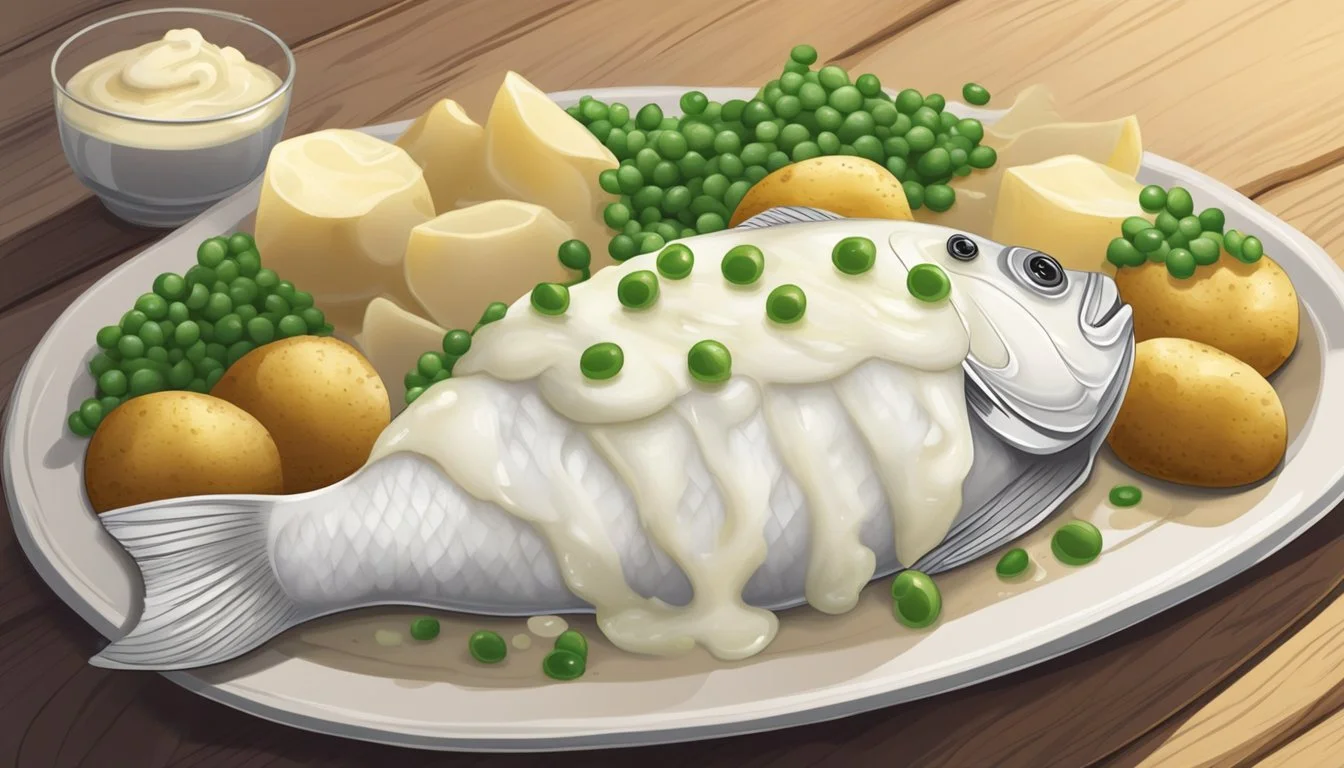Lutefisk Unveiling the Unique Scandinavian Delicacy of Lye-Cured Fish
Lutefisk is a traditional Scandinavian dish known for its distinctive preparation and unique, jelly-like texture. This culinary curiosity is made from dried whitefish, usually cod, though ling and burbot are also used. The process involves soaking the dried fish in cold water for several days, then in a solution of water and lye, which gives lutefisk its characteristic consistency and enhances its flavor. The fish is then soaked in fresh water again to remove the lye, making it safe for consumption. The end product is a dish that can elicit strong reactions; some celebrate its cultural significance and unique taste, while others approach it more cautiously.
Regarded as an acquired taste, lutefisk has a long-standing place in Norwegian, Swedish, Finnish, and even some American cultural traditions, particularly in regions with significant Scandinavian populations like Minnesota. It is often enjoyed as part of the Christmas season festivities, accompanied by varied side dishes such as pea stew, bacon, or mustard. While the origins of lutefisk are debated, some theories suggest it dates back to the Viking Age, indicating not just a rich culinary history but a sense of heritage and identity among its enthusiasts. Whether embraced or politely declined, lutefisk remains a distinctive emblem of Scandinavian cuisine.
Origins and History
Lutefisk has a storied past deeply rooted in Nordic tradition, with a history that stretches back to the Medieval period. Its preservation method has allowed it to traverse oceans and find new homes among Nordic communities across the globe.
Nordic Roots
The origins of Lutefisk can be traced back to the Vikings of Norway and Sweden, where it is believed to have originated in the Medieval Age. The process involves taking dried whitefish, traditionally cod, and soaking it in water and lye, a caustic alkaline substance. The lye infusion initially raises the pH of the fish, leading it to a jelly-like texture after a series of soaks and rinses. This method was not only a means to preserve the fish but also to reconstitute it during the long, dark winters, particularly as part of Yule and Christmas celebrations.
Worldwide Spread
While lutefisk is still enjoyed in its countries of origin, Norway and Sweden, it has also spread to other countries, notably Iceland and various regions with significant Scandinavian diaspora, such as parts of the United States. The dish crossed the Atlantic with Norwegian and Swedish immigrants and has maintained its role in holiday traditions and ethnic feasts, especially around Christmas time. Despite its distinctive preparation and flavor—which some might describe as an acquired taste—lutefisk continues to resonate as a symbol of heritage among Scandinavian communities far from its icy Nordic beginnings.
Ingredients and Preparation
In the traditional preparation of Lutefisk, lye plays a critical role, and the choice of fish is essential. The process involves several steps, from soaking the fish to serving it with appropriate sides.
The Role of Lye
Lye, a potent alkaline solution, is key to making Lutefisk. It transforms the texture of the fish, giving it the characteristic gelatinous consistency. Care must be taken to handle lye with caution, as it is a caustic substance.
Initial Soaking: The dried whitefish, typically cod, is first soaked in cold water for several days.
Lye Treatment: After the initial soak, the fish is submerged in a lye solution for another few days.
Final Soaking: The lye-infused fish must then be soaked in cold water for an additional period to remove any excess lye.
Fish Selection
Selecting the right type of fish is crucial for Lutefisk. Cod is the most commonly used, but other whitefish like pollock or haddock can also be used.
Quality of Fish: The fish should be high-quality, dried whitefish.
Preparation for Soaking: Before the lye treatment, the fish needs to be properly cleaned and prepared for soaking.
From Soaking to Serving
Once the fish has been treated with lye and properly rinsed, it's ready for the final preparation steps.
Cooking the Fish: Bake the treated fish in a preheated oven at 225°C for 30-40 minutes.
Serving Sides: Traditional Lutefisk is served with sides like:
Boiled potatoes
Mashed green peas
Crispy bacon
Additional Toppings: It is often topped with melted butter and accompanied by flatbread or lefse.
Note: Eggs are not a traditional ingredient in the preparation of Lutefisk, and the focus is rather on the texture and simplicity of the fish in combination with the sides.
Culinary Techniques and Variations
Lutefisk's distinctive preparation techniques contribute heavily to its unique texture and flavor, which vary across regions and with modern culinary experiments.
Regional Recipes
Norway and Sweden stand at the heart of lutefisk tradition. In Norway, the dish is synonymous with Christmas and typically features cod as the whitefish of choice. Chefs rehydrate the dried cod by soaking it in cold water for several days, replacing the water daily to remove impurities. Then, it's treated in a lye solution before a final soaking in water to ensure it's suitable for consumption. This meticulous process results in a gelatinous texture that either enlivens the festive spirit or sparks polite declines at the dinner table. Common accompaniments include boiled potatoes, mashed green peas, and melted butter, occasionally garnished with fried bacon.
In Sweden, lutefisk is similarly cherished during the Yuletide with local adaptations. Traditionally, the lye-infused fish may be seasoned with a touch of allspice or black pepper to enhance its mild, somewhat pungent taste.
In the United States, particularly in regions with dense Scandinavian heritage, lutefisk dinners are a nod to cultural roots. The preparation and sides may resemble that of Norwegian or Swedish customs, but variations are not uncommon due to availability of ingredients or personal taste.
Modern Twists
Chefs have explored modern interpretations of lutefisk, aiming to attract those less acquainted with its traditional appeal or appease the palate of long-time enthusiasts looking for a nuanced experience. Some may introduce smoky flavors or use garnishes to add texture contrast to the soft, jelly-like lutefisk. Creative sides like crispy bacon bits or a rich cream sauce are popular pairings to balance out the strong flavor profile.
Innovative cooking methods, such as baking or grilling, are also employed to either enhance or mellow the fish's naturally potent aroma, depending on diner preferences. While respectful of lutefisk's roots, these new adaptations can be the bridge that connects traditional Scandinavian kitchen lore with the curious taste buds of the 21st century.
Cultural Significance
Lutefisk holds a unique place in Scandinavian culture, particularly within Norway and Sweden, where it is not only a food item but also a symbol of heritage and festive customs.
Festivals and Celebrations
In Sweden and Norway, lutefisk is traditionally associated with the pre-Christmas season and is typically served at various events leading up to the holidays. Festivals dedicated to this lye-infused dish provide a space for communities to gather and celebrate their shared cultural identity. In the United States, especially in areas with large communities of Scandinavian descent, lutefisk dinners are a common feature in the run-up to Christmas, binding people with their ancestral customs.
Family and Tradition
Lutefisk is deeply embedded in family traditions, often passed down through generations. Serving lutefisk during holiday meals is a practice that ties families to their Scandinavian roots. The dish is a staple at many family celebrations and is particularly revered by elders, who view it as a cherished link to their past. For many, the meticulous preparation and enjoyment of lutefisk is an homage to their heritage and a reflection of ethnic pride.
Nutrition and Health
In exploring the nutritional profile of Lutefisk, one must consider its high-protein content and the potential health benefits and concerns associated with its unique preparation. This section will dissect its dietary aspects and address common controversies and myths.
Dietary Aspects
Lutefisk is made from whitefish, which is inherently rich in proteins and Omega-3 fatty acids. These nutrients are essential for maintaining muscle health and supporting cardiovascular health. The dish's protein content contributes significantly to the daily recommended intake, which underscores its potential as a beneficial component in a balanced diet.
Proteins: Vital for cell repair and muscle growth.
Omega-3 Acids: Play a crucial role in heart health and cognitive function.
Controversies and Myths
Despite its nutrient-rich base, Lutefisk is surrounded by health-related controversies primarily due to its lye-infused preparation. Concerns arise over the potential chemical residue that might remain in the fish. However, thorough washing and cooking transform the lye into harmless compounds, mitigating health risks.
Lye Concern: Proper preparation ensures that lye is neutralized, posing no health threat.
Health Myths: It is sometimes falsely believed that Lutefisk is unhealthy due to its odorous nature; however, the smell does not reflect its healthfulness.
Considering Lutefisk's protein and Omega-3 content, it can be a healthy choice if properly prepared. It is essential to understand both its dietary worth and the implications of its unconventional preservation method.
Taste Experience
In exploring the sensory journey of Lutefisk, a dish steeped in tradition, one must prepare for a unique taste profile influenced by its distinctive preparation method. The dish offers a culinary challenge that intersects with cultural heritage and personal expectations.
First Timers
For those tasting Lutefisk for the first time, the initial sensory impact can be quite striking. Lutefisk's texture is gelatinous, a result of its treatment with lye and subsequent rehydration process. The taste is mildly fishy, often accompanied by a subtle soapy aftertaste and a faint hint of ammonia. Consumers' initial reactions can range from surprise to apprehension, largely influenced by the expectation of what fish should taste and feel like.
Texture: Gelatinous
Flavor: Mildly fishy with soapy and ammonia undertones
Acquired Taste Phenomenon
Lutefisk's flavor complexity classifies it as an acquired taste for many. An acquired taste typically involves a sensory perception that may not be immediately pleasurable but can become enjoyable or even preferable over time and with repeated exposure.
Factors influencing acquired taste:
Cultural significance: Cultural context can enhance appreciation.
Repetition: Repeated exposure can lead to a shift in taste perception.
Social setting: Enjoyment can be amplified in communal dining experiences.
With repeated experiences, diners may shift their sensory perception, gradually finding pleasure in the flavors and textures they once found challenging, leading Lutefisk to transition from a novelty to a traditional favorite.
Comparison with Other Foods
In examining Lutefisk, it's illuminating to compare it with other distinct global foods that challenge the palate and sometimes require an acquired taste to be appreciated.
Similar Dishes
Hákarl and Surströmming: Like Lutefisk, these are Nordic seafood dishes that are notorious for their strong odors and flavors. Hákarl, from Iceland, is fermented shark and is known for its ammonia-rich scent, while Surströmming, from Sweden, is fermented Baltic herring with a potent smell.
Nattō: This is a Japanese breakfast staple consisting of fermented soybeans. Its stringy texture and pungent aroma can be compared to the jelly-like texture and distinctive odor of Lutefisk.
Commonalities:
All are traditional to their respective cultures.
Each requires a process of fermentation or treatment with particular chemicals (like lye for Lutefisk and nattō) to achieve the final product.
They are typically polarizing among diners.
Unique Aspects
Delicacy Status: Lutefisk holds a similar distinction as Caviar and Durian among unique foods, where it is considered a delicacy in its native cultural context. Caviar, known for its luxurious status, is prized for its texture and taste. In contrast, Durian, often called the "king of fruits," is infamous for its overpowering smell.
Cultural Significance:
Haggis: This Scottish dish made from sheep's offal mixed with oats and spices shares the cultural significance with Lutefisk, each being a symbol of their nation's culinary heritage.
Lutefisk is specifically associated with holiday traditions in Norway and the wider Scandinavian region.
Acquired Taste:
Lutefisk shares the quality of being an acquired taste with foods like Hákarl, Caviar, Haggis, Durian, and Nattō.
The initial tasting may be surprising or off-putting to some; appreciation often develops over time.
Texture & Preparation:
Lutefisk's gelatinous texture due to lye treatment sets it apart from firmer textured foods like Caviar or the pudding-like consistency of Haggis.
It requires careful preparation, similar to ensuring Caviar doesn't spoil or Durian is ripe without being overripe.
In their uniqueness, these foods embody the rich tapestries of their culinary heritages and reveal the diverse palate of global cuisines.
Challenges and Preservation
In the context of Lutefisk, challenges largely revolve around the sustainability of the fish species used and the cultural preservation of this unique culinary tradition.
Sustainability Issues
Sustainability concerns for Lutefisk start at the source - the fish. Traditionally made from whitefish like cod, ling, haddock, or pollock, the demand for Lutefisk could contribute to overfishing if not managed responsibly. It's imperative that those involved in the fishing practices prioritize:
Regulated Fishing: Guidelines must be enforced to prevent depletion of whitefish stocks.
Eco-Friendly Methods: Fishing techniques should minimize by-catch and habitat destruction.
Revival Efforts
Despite its notoriety, Lutefisk's consumption has been waning in its countries of origin, while it has found a niche following among Scandinavian-Americans. Preservation of the Lutefisk tradition requires concerted efforts:
Cultural Celebrations: Incorporating Lutefisk in festivals and community gatherings fosters continued interest.
Identity Preservation: For many Scandinavian-Americans, eating Lutefisk is a statement of cultural identity, fueling its survival.
Conclusion
Lutefisk represents more than just a dish; it is a testament to Scandinavian culinary heritage. This lye-infused food, often associated with holiday traditions, epitomizes the unique flavors that define Norway's gastronomic culture. Generations have preserved the methodical preparation of Lutefisk, ensuring that its peculiar taste and texture endure.
With culinary innovation on the rise, Lutefisk may see variations in its classic recipe. Chefs have the potential to experiment with different condiments and sides, possibly making it more palatable to a wider audience. Despite differing opinions about its appeal, Lutefisk continues to be a topic of discussion and a cultural hallmark.
The future prospects of Lutefisk depend on its ability to transcend borders and adapt to contemporary tastes while keeping its historical significance intact. Scandinavian communities globally, particularly in places like Minnesota, USA, continue to celebrate this traditional dish, indicating its lasting popularity.
It can be said with confidence that Lutefisk is here to stay. As an acquired taste, it may not resonate with everyone, yet it presents a unique culinary challenge and an opportunity to explore the depths of traditional Nordic flavors. It does more than satiate; it connects people to a rich history and invites curiosity about the region's charming customs.









